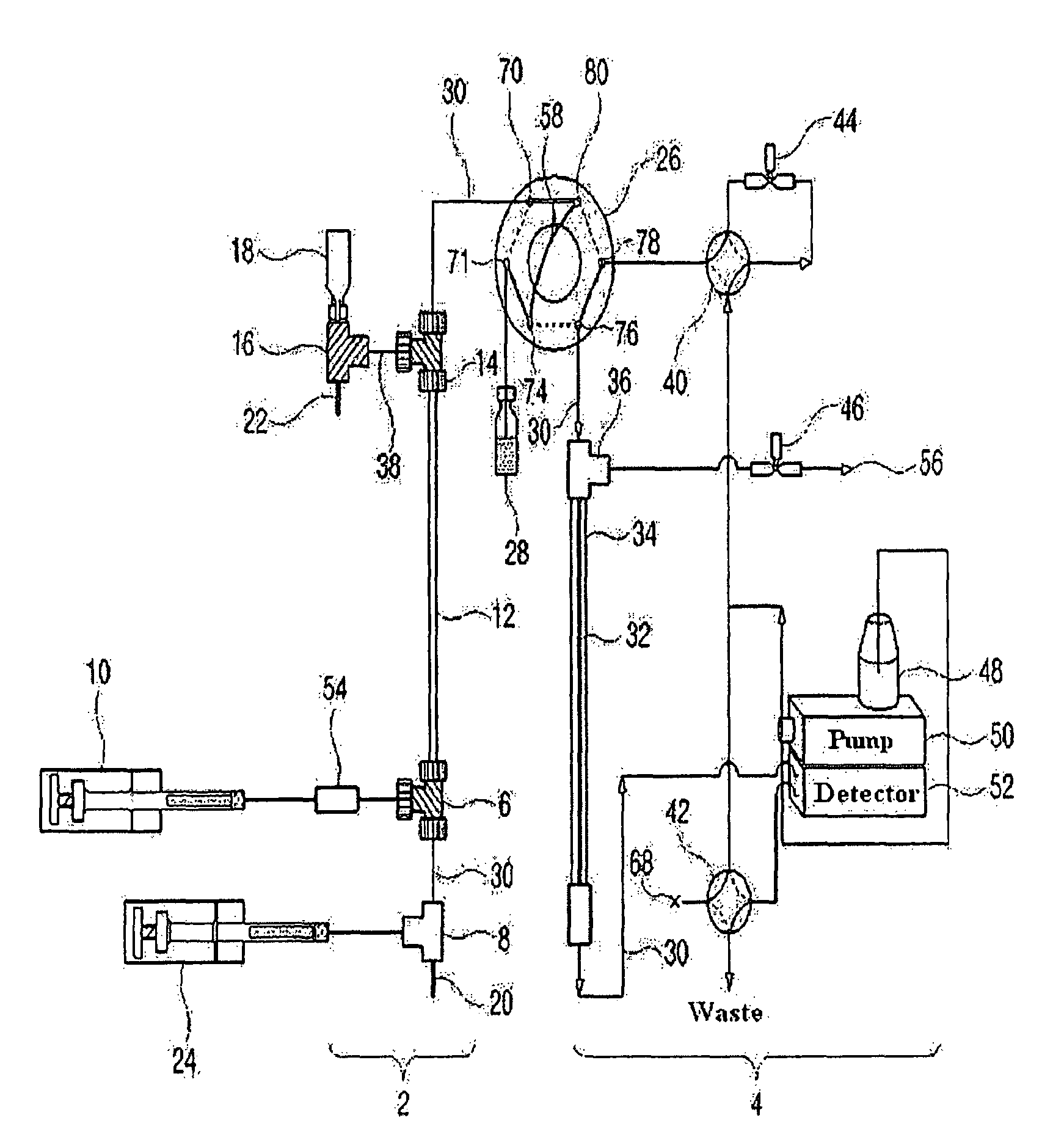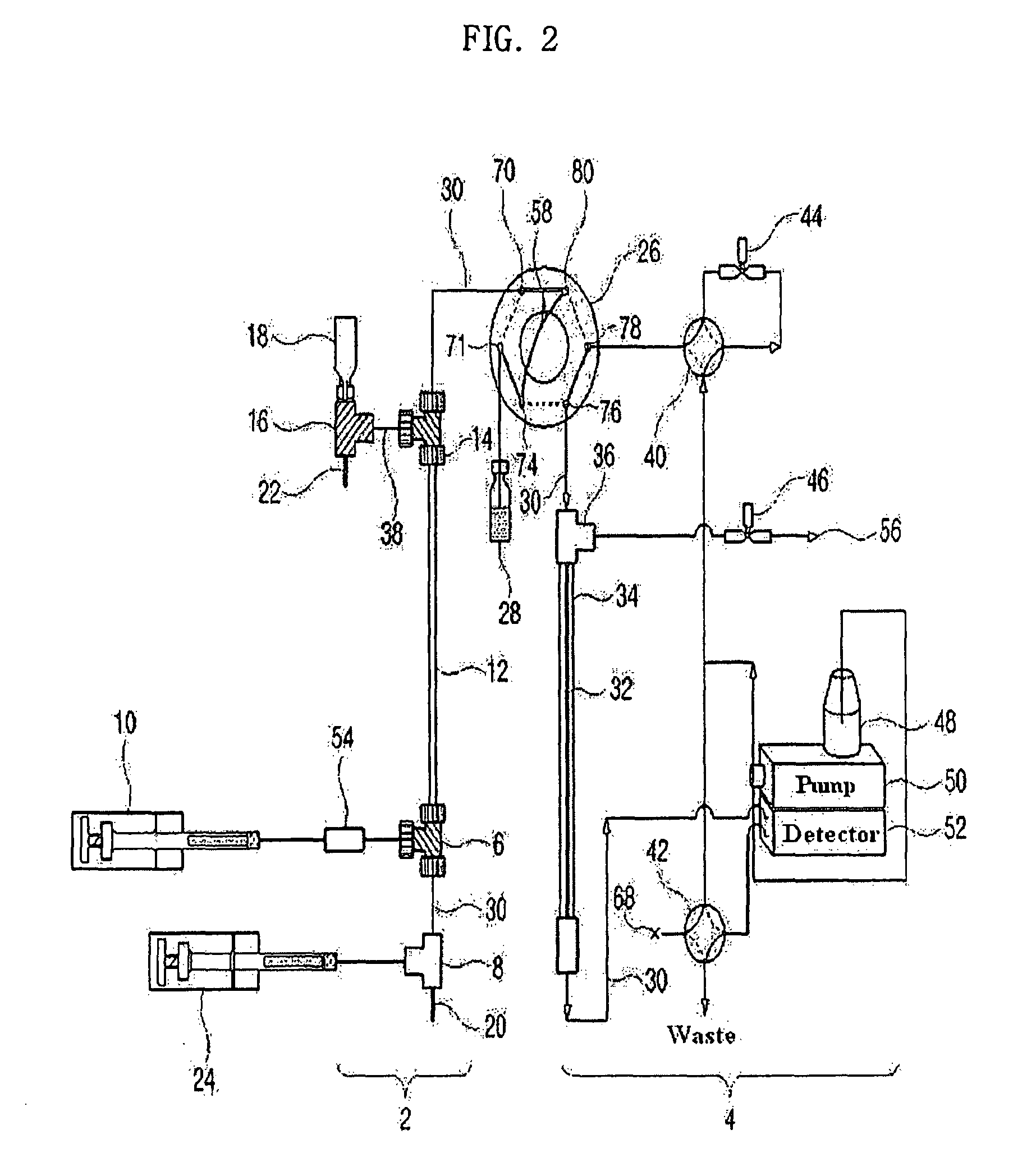Apparatus for protein separation using capillary isoelectric focusing-hollow fiber flow field flow fractionation and method thereof
a technology of capillary isoelectric focusing and protein separation, which is applied in the direction of fluid pressure measurement, liquid/fluent solid measurement, peptides, etc., can solve the problems of protein trapped in the gel, difficult to separate and discern the mixture of numerous different proteins comprising a proteome, and labor-intensive 2d-page techniqu
- Summary
- Abstract
- Description
- Claims
- Application Information
AI Technical Summary
Benefits of technology
Problems solved by technology
Method used
Image
Examples
example 1
Construction of Protein Separation Apparatus
[0135]As shown in FIG. 2, a 9.5 cm×310 μm (inner diameter) Teflon capillary [Vernon Hills, Cole-Partner, USA], serving as an isoelectric focusing capillary, was provided at one end thereof with two MicroTees [Upchurch Scientific, USA] in sequence, which were connected with each other via a silica capillary [Phoenix, Polymicro Technologies, USA] having an outer diameter of 360 μm and an inner diameter of 50 μm.
[0136]Next, a union [Delrin Standard Union, Upchurch Scientific, USA] and a syringe pump [Harvard Apparatus 22, Harvard Apparatus, USA] were sequentially connected to one side of the first MicroTee. The second MicroTee [Upchurch Scientific, USA] was connected at one side to a syringe pump [Harvard Apparatus 22, Harvard Apparatus, USA] and at another side to a platinum electrode serving as an anode. The syringe pump communicating with the first MicroTee was filled with protein samples [myoglobin (15 kDa, pI 6.8), trypsinogen (24 kDa. p...
example 2
Separation of Protein Standards by Capillary Isoelectric Focusing-Hollow Fiber Flow Field Flow Fractionation Apparatus
[0142]A mixture of five protein standards was prepared as a specimen for testing the resolving power of the protein separation apparatus (capillary isoelectric focusing-hollow fiber flow field flow fractionation apparatus) constructed in Example 1. The composition of the protein mixture is given in Table 1, below.
[0143]
TABLE 1ProteinsPropertiesContent (ng)1Myoglobin15 kDA, pI6.81252Trypsinogen24 kDA, PI9.82003Carbonic anhydrase29 kDA, pI5.85504Bovine Serum albumin66 kDA, pI4.81805Yeast alcohol dehydrogenase150 kDA, pI6.23250
[0144]After being loaded with the protein mixture of Table 1 and an ampholyte (5% v / v), the first syringe pump of the protein separation apparatus, constructed as in Example 1, was operated to supply the mixture solution to the Teflon capillary. Then, the isoelectric focusing of the protein mixture was performed by applying an electric field of 50...
example 3
Separation of Human Urinary Proteins by Capillary Isoelectric Focusing-Hollow Fiber Flow Field Flow Fractionation Apparatus
[0159]The protein separation apparatus constructed in Example 1 (capillary isoelectric focusing-hollow fiber flow field flow fractionation apparatus) was applied for the separation of the proteins extracted from human urine.
[0160]In order to employ protein samples having a molecular weight of 30 kDa or greater, urine was filtered through a membrane with 30 kDa cutoff.
[0161]The same procedure as in Example 2 was performed, with the exception that 40 μg of the filtered urinary protein sample was used instead of the protein mixture and isoelectric focused protein fractions had six respective pH zones. Protein fractions with a pH range of 9-10, 8-9, 7-8, 6-7, 5-6 and 3-5 were injected in that order and separated by hollow fiber flow field flow fractionation.
[0162]The results are shown in FIG. 7. Nanoflow LC-MS-MS was used for protein identification.
[0163]As seen in ...
PUM
| Property | Measurement | Unit |
|---|---|---|
| time | aaaaa | aaaaa |
| electric field | aaaaa | aaaaa |
| outer diameter | aaaaa | aaaaa |
Abstract
Description
Claims
Application Information
 Login to View More
Login to View More - R&D
- Intellectual Property
- Life Sciences
- Materials
- Tech Scout
- Unparalleled Data Quality
- Higher Quality Content
- 60% Fewer Hallucinations
Browse by: Latest US Patents, China's latest patents, Technical Efficacy Thesaurus, Application Domain, Technology Topic, Popular Technical Reports.
© 2025 PatSnap. All rights reserved.Legal|Privacy policy|Modern Slavery Act Transparency Statement|Sitemap|About US| Contact US: help@patsnap.com



